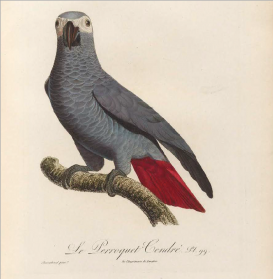“The Global Grey Parrot” puts a charismatic African animal (Psittacus erithacus and P. timneh) at the center of world history. Drawing on diverse sources and methods, “The Global Grey Parrot” moves through centuries and around the globe. This more-than-human history is environmental and economic and also explores cognition and affect, revealing fraught more-than-human politics. It also connects non-human networks to human exclusions of race and class.
It begins in African forests before 1500, where Greys shared knowledge and culture in flocks. Encaged and exported to the Atlantic World, they retained their social expectations. When tamed, they do not readily submit to discipline but act out their trauma. During centuries of captivity, Greys and people developed their knowledge of each other, through experience, but only humans transmitted their knowledge to others. Isolated creatures cannot produce culture.
Now, in the Anthropocene, Greys are trafficked from their native habitat as one more commodity demanded from Africa by global markets. They are also bred in agro-industrial facilities, many produced far from their native forests in South Africa, where labor costs allow profitability. As wild populations decline and captive ones grow, the Greys’ collective experience is increasingly of confinement in human spaces. Sanctuaries and re-wilding projects offer respite from human demands. Human-parrot co-parenting of chicks may show how to create a common culture and bequeath it to offspring of both species. Recognizing parrots’ historical world-making could foster mutual world-making.

